A tribute to the fathers of Western civilization. Analysis of: "The school of Athens" by Raphael
| Author | Raphael |
|---|---|
| Year | 1509-1510 |
| Technique | Fresco |
| Style | Renaissance |
| Dimensions | 200 in × 300 in |
| Location | Apostolic Palace, Vatican City |
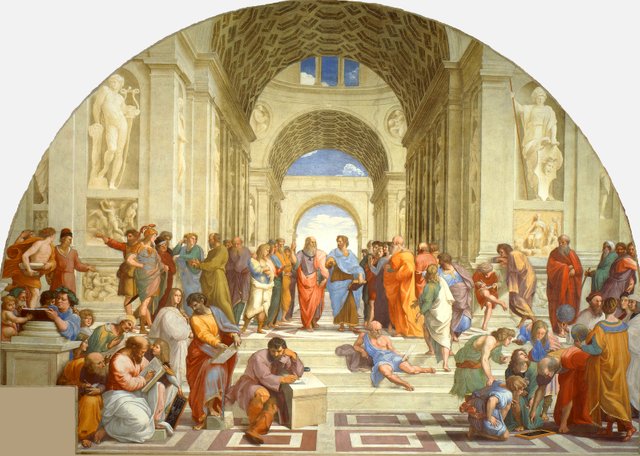
Let's continue reviewing artistic expressions of the Renaissance, in this case we will analyze "The School of Athens". I must confess that I am very excited to give you a review about this painting, an image that give us a lot of information in each of the characters represented and their environment. I always try to look for images that readers can quickly recognize so that they feel identified and want to learn a little more about them, I believe this image will fulfill that objective. Although you may not be able to identify some of the characters at first sight (it happened to me), I am sure you'll recognize their names. With nothing more to add, let's start.
Context
"The School of Athens" is not only a marvelous work of art from a technical point of view but it is also a very valuable historical painting in which the author seeks to unite classical antiquity with the Renaissance. It was painted by Raphael between 1509 and 1510 by order of Pope Julius II who chose him to do this work advised by the architect Bramante, at the same time Michelangelo was painting the vault of the Sistine Chapel.
This fresco is located in the Room of the Signature along with three other murals, each mural has a specific theme: theology, poetry, law and philosophy. The Room of the Signature is one of the four rooms that make up what is known as Raphael Rooms, located on the second floor of the Apostolic Palace. These rooms were chosen by Julius II and his successors as a personal residence. Its decoration started in 1508 by Raphael and was completed by his disciples in 1524 after he died in 1520.
No doubt this is one of the most representative images of art history and perhaps the best known work of the author, Raphael sought to represent the origins of Western thought emerged in Ancient Greece also wanted to highlight the value of the seven liberal arts: grammar, arithmetic, music, geometry, rhetoric, dialectic and astronomy.
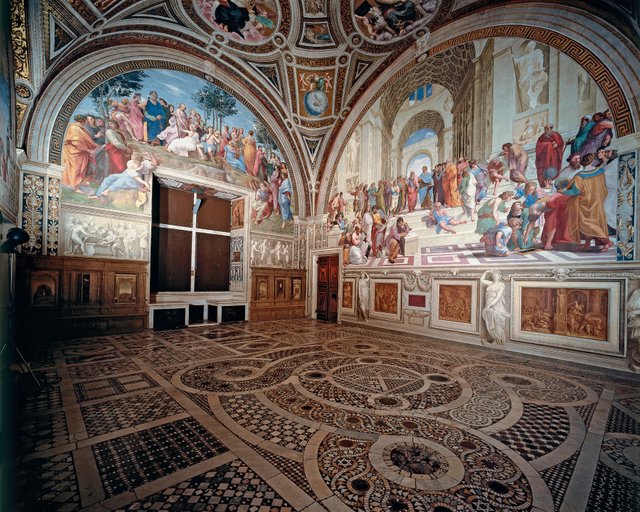
Analysis
Rafael dares to place the artists of his time on the same level with the parents of philosophy, mathematics and science, he is aware that the Renaissance is the beginning of something, that is why he not only gives value to these ancient thinkers but seems to consider them equal to their colleagues.
This is why the face of Plato is a portrait of Leonardo da Vinci, Heraclitus is Michelangelo and Euclid or Archimedes (there is no total consensus on who are some characters) is Bramante, while Raphael himself self-portrays among astrologers.
The School of Athens symbolizes Philosophy, the scene, dominated by perspective, is located in a kind of Greco-Roman inspired temple of wisdom that closely resembles the architecture of St. Peter's Basilica. The sculptures that rise above the rest of the characters are Apollo (the niche on the left) and Athena (in the niche on the right), Apollo is the allegory of harmony and sobriety, his image is based on a sculpture of Michelangelo called "The dying slave", meanwhile Athena represents wisdom and peace.

Rafael chose to represent the most influential personalities of antiquity, led by Plato and Aristotle who are at the center of the composition. The books that each one carries reflect their philosophy, Plato holds "Timaeus", a book where he explains his famous theory of forms, while Aristotle holds his book "Ethics", a text made up of philosophical treaties about morality.
The body language of both is quite important, Plato points his index finger upward, representing the abstract and theoretical philosophy, while Aristotle keeps his hand down, symbolizing the natural and empirical philosophy, a less idealistic way of seeing the world in comparison to his teacher.
To the left of the central group, we find from left to right Alexander the Great, Aeschines, Xenophon and Socrates respectively. Alexander the Great was king of Macedon and student of Aristotle, he's in military clothing and listening to Socrates. Socrates was the teacher of Plato and the creator of the Socratic method, together with Aristotle, the three are the most important and representative thinkers of the Ancient Greece. Xenophon was a historian, military and philosopher famous for recounting the Peloponnesian War, Aeschines was an Athenian politician and orator.
In the lower left corner is Zeno of Citium and next to him Epicurus with a crown of grape leaves. This Greek philosopher spread that happiness was based on the pursuit of the pleasures of the mind. A little further to the right we can see Pythagoras, Hypatia and Parmenides. Pythagoras was perhaps the most important Greek mathematician, he appears with a blackboard explaining his theorems to Anaximander. Hypatia of Alexandria (the only female figure) is a portrait of Margherita Luti, a lover of Raphael, she was a neoplatonic philosopher with knowledge in geometry, algebra and astronomy. Parmenides, was the founder of the Eleatic school, his only work that still persists is a philosophical poem.
Moving to the center we find Heraclitus, a melancholic philosopher who suffered constantly for the inability of people to see "the real world". To the right, recumbent on the stairs, is represented Diogenes the Cynic. Diogenes became famous because he denied earthly possessions and social conventions. A little lower and to the right of Diogenes is Euclid (others say that Archimedes), a Greek mathematician and disciple of Socrates, he is exhibiting one of his geometrical principles.
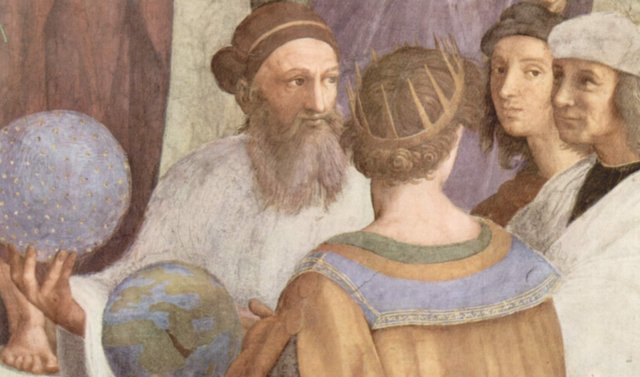
Along with Euclides, we find Ptolemy, Zoroaster and Raphael's self-portrait that looks directly at the viewer. Ptolemy was an astronomer and geographer, holding a terrestrial globe, which alludes to his claim that the Earth was the center of the universe. Beside him is Zoroaster, a famous Persian prophet.
Technique
This painting transmits a feeling of confidence and harmony, this is due to the brightness of the colors, the abundant luminosity of the surroundings, the elegance of the composition and the natural gestures of the figures.
In this work the perspective and depth achieved is amazing, Rafael applies the linear perspective, influence received from Leonardo. We observe that the vanishing point coincides with the center of the arc over Plato and Aristotle, which makes every look towards the scene goes the center, towards the figure of the two philosophers.
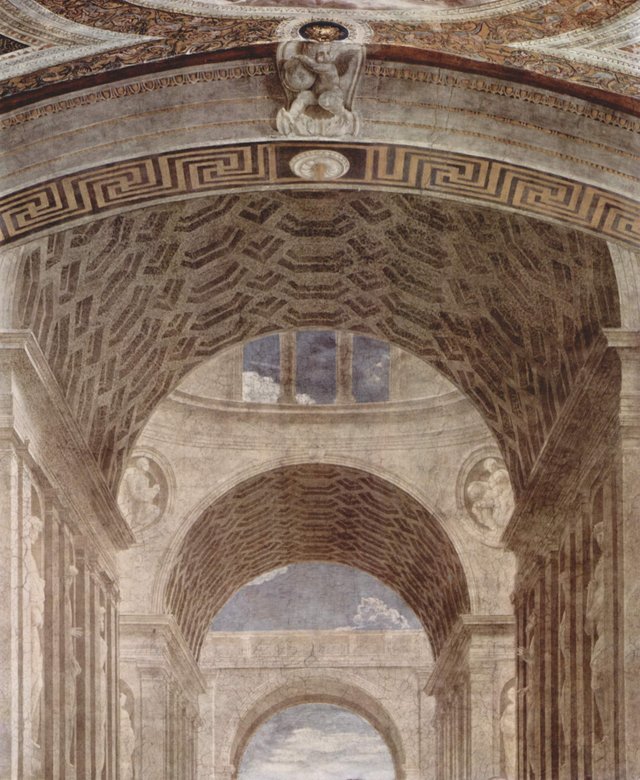
The light comes from the upper part of the painting, it is a diaphanous light that illuminates the whole composition. The contrasts of lights and shadows are balanced, using color to define shapes and volumes, a technique that also recalls the Da Vinci’s "sfumato" .
The composition is symmetrical, we find a large vertical axis between Plato and Aristotle that divides the painting into two parts, and a horizontal axis that passes above the heads of the people who are on the stairs. The distribution of groups of people is based on these axes, each group gives a sense of movement, the figures are linked among others offering a magnificent example of harmony and elegance.
Curiosities
All the great works of Rafael were the result of a very detailed planning. Many of his preliminary drawings were made of real characters and then work on the poses and expressions of the models. This artist made real scale designs and then moved them to the wall where the fresco was going to appear.
The painter's signature is on the embroidery of the neck of Euclid (or Archimedes). It is something unusual because in a commission from the church it was forbidden for the artist to record his authorship to prevent him from falling into the sin of pride.
Images extracted from Wikipedia
My recent posts
Review of "Liberty leading the people" by Eugene Delacroix
Review of "Starry night" by Vincent Van Gogh
Review of "The persistence of memory" by Salvador Dali
Review of "The birth of Venus" by Sandro Botticelli
Review of "The creation of Adam" by Michelangelo
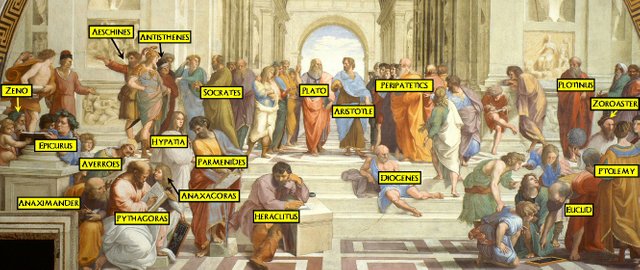
Great post mate! Who would have know that there was so much behind a Fresco? The attention to detail is amazing!
Thanks, this masterpiece can be admired for hours and even then you can discover new things.
Upvoted, and followed..... My #kryptonia username is : diamondrich
Nice, you have been added to the official @ARTzONE voting list.
Thanks, i appreciate it
Ooooh, it's yours. I always forget that I Can use Artzone too. I should head to the Discord. We haven't talked in a month now.
interesting art work @jamescrusader
Upvoted
great article, makes a lot of meaning. kryptonia id @ofili2
You got a 15.62% upvote from @emperorofnaps courtesy of @alejandromata!
Want to promote your posts too? Send 0.05+ SBD or STEEM to @emperorofnaps to receive a share of a full upvote every 2.4 hours...Then go relax and take a nap!
interesting article. kryptonia ID @grace234
You got a 1.82% upvote from @upmewhale courtesy of @alejandromata!
Earn 100% earning payout by delegating SP to @upmewhale. Visit http://www.upmewhale.com for details!
Great post!
Thanks for tasting the eden!